|
|
|
Sort Order |
|
|
|
Items / Page
|
|
|
|
|
|
|
| Srl | Item |
| 1 |
ID:
133995
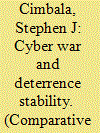

|
|
|
|
|
| Publication |
2014.
|
| Summary/Abstract |
Nuclear deterrence and cyber war are often discussed as separate worlds of research and military-strategic practice. To the contrary, a certain degree of overlap between nuclear deterrence and cyber conflicts is a plausible expectation for several reasons. First, future deterrent challenges will include regional nuclear arms races accompanied by competition in information technology and other aspects of advanced conventional command-control and precision strike systems. Second, cyber-attacks may be used against opposed nuclear command-control systems and weapons platforms as well as against infrastructure for the purpose of mass disruption during a crisis or war. Third, cyber capabilities support escalation dominance or escalation control, depending on the objectives of states and on the transparency of identification for cyber friends and foes.
|
|
|
|
|
|
|
|
|
|
|
|
|
|
|
|
| 2 |
ID:
133793
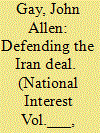

|
|
|
|
|
| Publication |
2014.
|
| Summary/Abstract |
Nuclear talks have yielded a framework that buys time for negotiation and reduces the risk of miscalculation on either side.
IT WAS LONG PAST MIDNIGHT IN GENEVA last November when the rumors began to fly. Iran and the world powers had just reached a deal on its nuclear program. An international crisis that had been building toward what seemed like war for more than a decade was now on the path to resolution. The deal, a haggard John Kerry confirmed, was real. It wasn't comprehensive-Iran would still be heavily sanctioned and heavily centrifuged-but it was unprecedented. All prior efforts had fallen apart.
|
|
|
|
|
|
|
|
|
|
|
|
|
|
|
|
| 3 |
ID:
134085
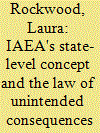

|
|
|
|
|
| Publication |
2014.
|
| Summary/Abstract |
In September 2013, the International Atomic Energy Agency (IAEA) Board of Governors reviewed a report by Director-General Yukiya Amano on efforts to further strengthen the effectiveness of safeguards and increase their efficiency.[1] The report described an approach to the implementation of safeguards that had come to be known as the "state-level concept."
|
|
|
|
|
|
|
|
|
|
|
|
|
|
|
|
| 4 |
ID:
114625
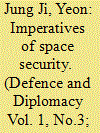

|
|
|
|
|
| Publication |
2012.
|
| Summary/Abstract |
In January 2012, the Obama Administration was reportedly sketching
a new space arms control initiative that would broadly contain
the European Union (EU) draft Code of Conduct.
1
Reportedly,
it is an attempt to outline the international norms and connote
commencement of the obligation for non-threatening activities in
space. It aims at encouraging transparency among nations that have
space programmes and diminishing the damage caused by hazardous
debris, and generally makes an international call for space security
considerations. However, this announcement implies the possibility
of an arms control treaty, which following the space policy unveiled
last year, is completely averse to the US unilateral stance supported
by the Bush Administration. Obama's new plan is domestically facing
tremendous critics, and there are concerns over the US space military
capability and dominance cornering into limitation.
|
|
|
|
|
|
|
|
|
|
|
|
|
|
|
|
| 5 |
ID:
132474
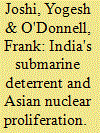

|
|
|
|
|
| Publication |
2014.
|
| Summary/Abstract |
New Delhi's plans for nuclear-armed submarines could undermine efforts to restrict fissile materials, and set off a naval arms race.
India has become a more or less accepted member of the global nuclear order, but the state's emerging undersea deterrent continues to be a source of concern. Its efforts to create nuclear-armed submarines began in the 1980s, and technical progress was slow during the project's first three decades. India has recently made some bold strides, however, and in 2009 unveiled its first nuclear submarine, INS Arihant. The boat is now undergoing sea trials, and is scheduled to be introduced into the Indian Navy by early 2015. Several similar vessels are under construction: New Delhi plans to field a fleet of between four and six nuclear-armed submarines by the end of the decade.
|
|
|
|
|
|
|
|
|
|
|
|
|
|
|
|
| 6 |
ID:
132011
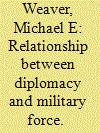

|
|
|
|
|
| Publication |
2014.
|
| Summary/Abstract |
Diplomacy and military force mutually support each other as instruments of national policy, functioning better in concert rather than as separate entities. The Cuban Missile Crisis is a useful case study of policymakers utilizing force and diplomacy synergistically. State Department efforts prior to the crisis paved the way for a unified front with Latin American neighbors against the emplacement of Soviet missiles in Cuba. With a backdrop of nuclear threats supporting the more usable capabilities of conventional air strikes, invasion forces, and blockading ships, the American threat of force made a negotiated settlement attractive to the leadership of the Soviet Union. The risks and political damage commensurate with the use of force encouraged the Kennedy administration to pursue a diplomatic solution. Military leaders tended to not consider the political effects of the use of force. President Kennedy understood the interrelationships between force and diplomacy, as did State Department leaders.
|
|
|
|
|
|
|
|
|
|
|
|
|
|
|
|
| 7 |
ID:
132469
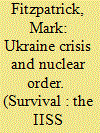

|
|
|
|
|
| Publication |
2014.
|
| Summary/Abstract |
On some issues, particularly Iran, the fallout has been negligible, yet there is still reason for concern. The gravest dangers are the devaluing of security assurances and cracks in the credibility of extended deterrence.
In the immediate aftermath of Russia's annexation of Crimea, gloomy predictions for the non-proliferation agenda were a commentariat staple. On some issues, particularly Iran, the fallout has so far been marginal. Yet there remains ample reason for concern, including over US-Russia cooperation on nuclear security. The gravest proliferation danger stemming from the crisis is the devaluing of security assurances of the kind provided to Ukraine in the 1994 Budapest Memorandum on Security Assurances and potential cracks in the credibility of extended deterrence.
|
|
|
|
|
|
|
|
|
|
|
|
|
|
|
|
| 8 |
ID:
132480
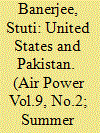

|
|
|
|
|
| Publication |
2014.
|
| Summary/Abstract |
Political instability, economic Volatility, the rise of the right-wing political leadership and an increase in the number of terrorist organisations operating from Pakistan and gaining the support of the Pakistani establishment have nations concerned about the safety of the nuclear assets within Pakistan. Adding to the problem is the well documented proliferation network that has supplied nuclear technology to North Korea, Libya and Iran, with Pakistan, at its centre. These actions have increased the problems and challenges that nuclear proliferation poses. The proliferation of nuclear weapons technology, associated technology and/ or nuclear material to any state or non-state actor, not recognised to receive such technology or material, is one of the most serious dangers to the international security environment. This contributes to not just regional instability and global proliferation, but also increases the risk of violent non-state groups obtaining a nuclear weapon, with a number of violent extremist groups opposed to
India operating from Pakistan. These issues have raised concerns among the international community about the security of Pakistani nuclear weapons. For the United States, Pakistan poses a serious dilemma. Pakistan has been an 'ally' of the United States during the Cold War and continues.
|
|
|
|
|
|
|
|
|
|
|
|
|
|
|
|
| 9 |
ID:
102334
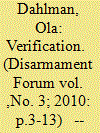

|
|
|
|
|
|
|
|